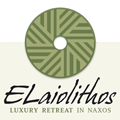I’d love to share about Moni village, nestled atop a verdant ridge in the mountainous heart of Naxos. This charming village holds special significance as it’s my mother’s hometown, offering a unique cultural experience often missed by travelers.
Moni is a hidden gem village that stands alone, without any advertisement or promotion. It is often underrated, but offers a unique experience of raw natural beauty, privacy, sustainable tourism, and an authentic glimpse into the local way of life and cultural traditions. With only 200 inhabitants, the village is full of life, but remains non-mainstream and is not actively promoted by locals or residents.
Moni village is a path less traveled that’s definitely worth exploring
What makes Moni village truly charming is its unspoiled authenticity, simplicity, and peacefulness. Unlike other crowded and popular tourist destinations in Naxos, Moni is not heavily marketed and remains relatively undiscovered. It offers visitors the opportunity to experience a slower-paced lifestyle, as well as the warm hospitality and the sense of connection from the locals. You can leisurely stroll through the narrow streets and alleyways, appreciate the traditional architecture, and peacefully observe the daily routines of the villagers.

Its Views & Energy
Moni village in Naxos is a place where time appears to have come to a standstill. It’s surrounded by lush greenery and boasts various historic sites, such as the oldest Byzantine Church of Balkans – Panagia Drosiani, remnants of classical windmills and predominantly stone-crafted dwellings. Many people know Moni as the “Balcony of Naxos” since it’s located high up on the undulating hills of the island, providing awe-inspiring panoramas of the stunning surroundings. Situated on the island’s heart edge, Moni village delivers a sweeping vista as far as the eye can see, that spans from the Aegean Sea to the rugged mountains and hills of the interior, making it a sight to behold.
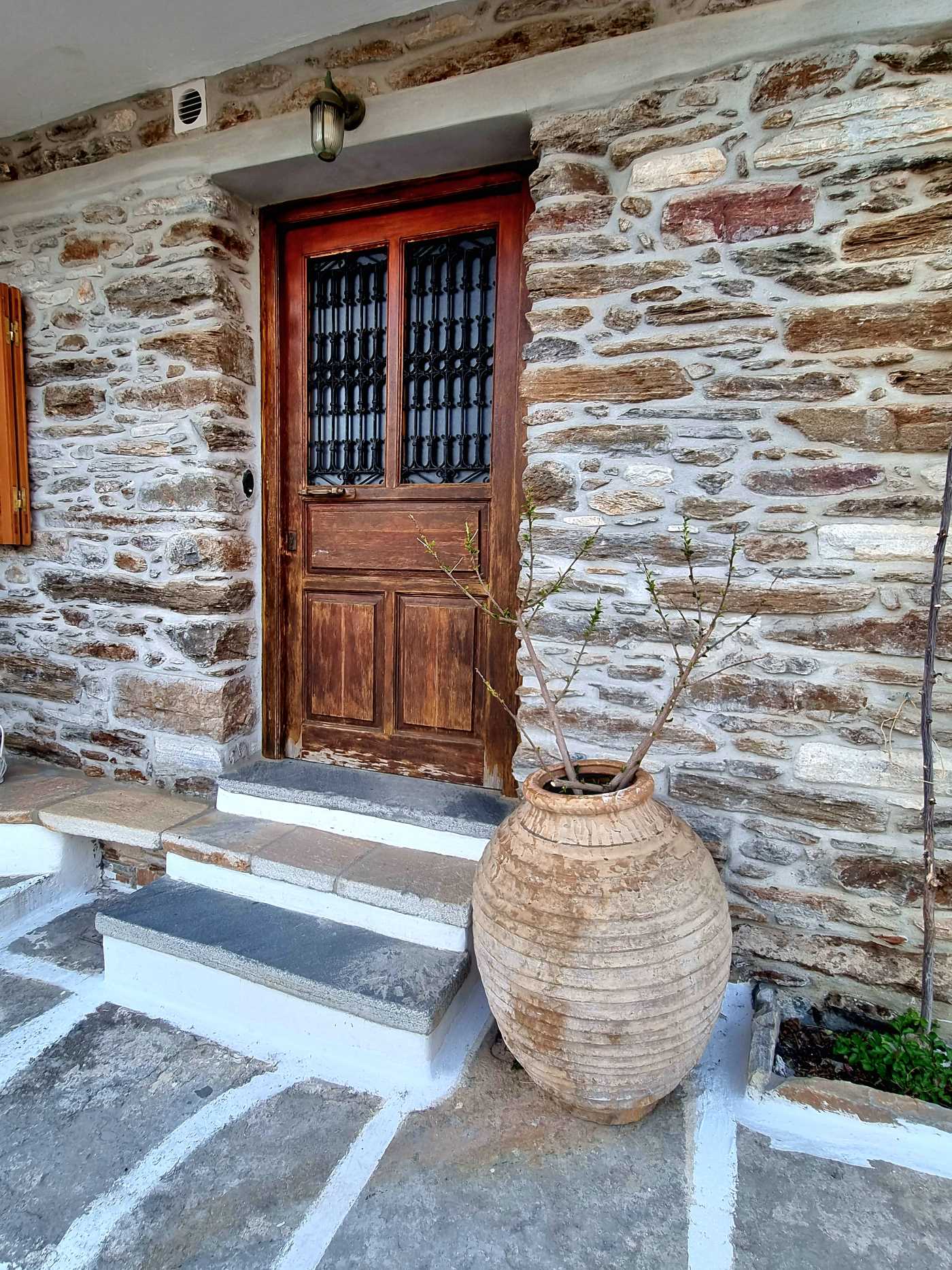
The natural position is so wisely chosen and harmonic to an environment that constitutes, admittedly, one of the most beautiful natural “balconies” to the Aegean Sea. Α “balcony” is like a non expected, open embrace, that smiles openly to the sun and gazes into the impressive landscape in front. This landscape, following the bubbling gurgling stream with the old stone bridge precisely next to the village, overflow as a torrent in the roots, shaping initially a green basin full of cultures, while, unexpectedly it tears in two parts the mountainous volume and leads hedonically in the sea, that is visible from Moni, even if it is situated in distance of 18 km. from Chora, Naxos town!

This incredible view, when the sky takes a clear blue color, reveals everything around, far to the Aegean Sea and allows the observer to see even the opposite at Paros. The view, therefore, this, in connection with the cultivated soil comes down from the ridge of Moni and extends in a big distance in front, surrounded by a ring of harmonic mountainous volumes in natural shapes of pyramids with protagonist the Zas mountain, the “eagle shaped” mountain that inspired the great poetry Odysseus Elytis who described it precisely in its leading work “Axion Esti”
…as the shades above in the mountain, with the raise of sun,
create the picture of a proud eagle with open wings
renders Moni village a unique energy place, that revives the body and the spirit in the minimum time and creates a feeling of euphoria and energy to everyone that experiences this condition.
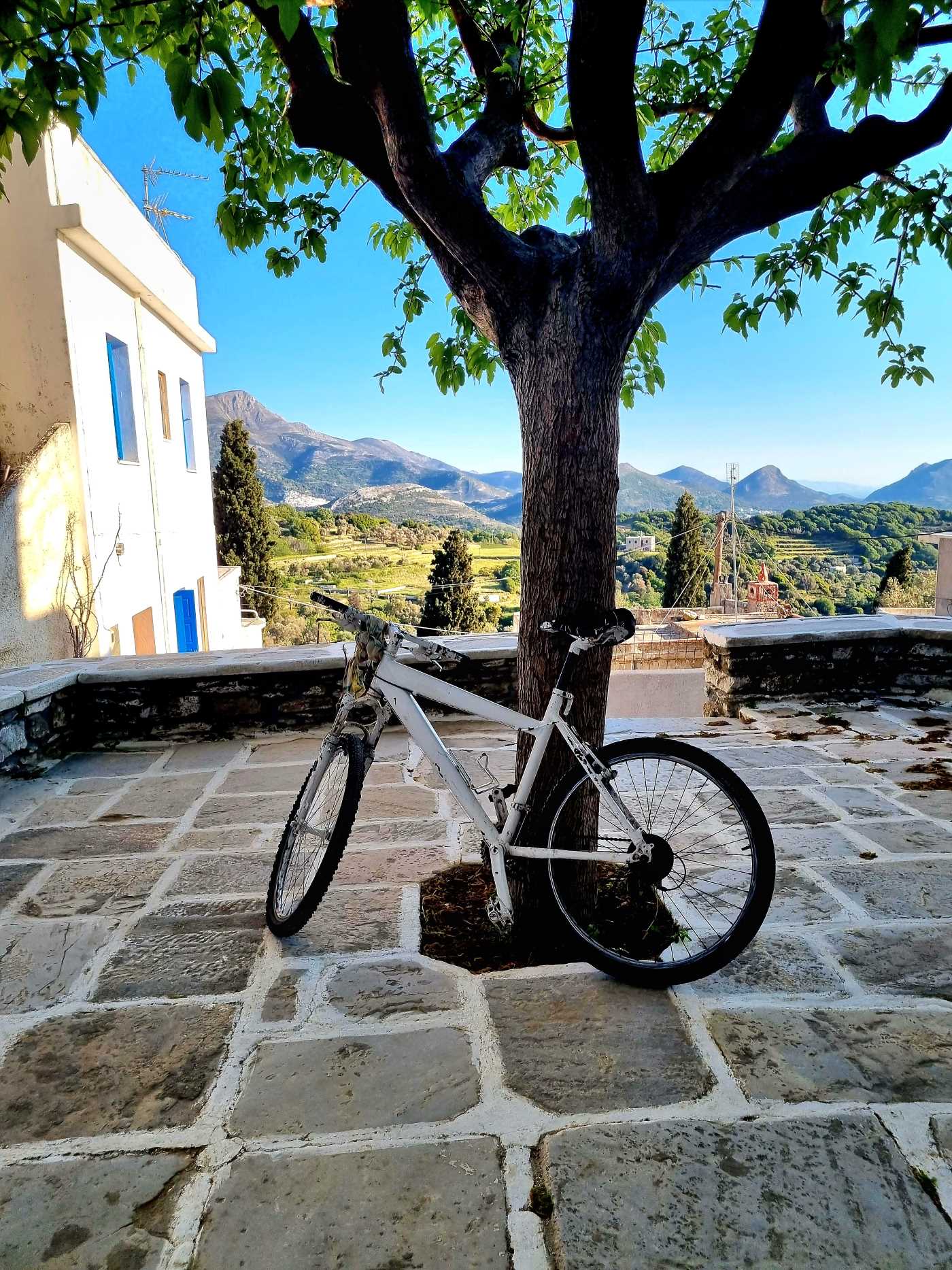
Its Residents
As a result of their self-sufficiency, the residents of Moni do not rely heavily on external sources for their food and other necessities. They are autonomous and take great care in producing and preparing their own food, which includes mostly everything a home needs. Visitors to the village can sample these local products and experience the authentic flavors of Naxos.

The residents of Moni exhibit a strong sense of community, take pride in their self-sufficient lifestyle, and know how to have a good time, which is reflected in their frequent gatherings and year-round celebrations. These simple gatherings often involve a lot of laughter, storytelling, and good-natured teasing. Visitors passing by are welcomed with open arms and are often invited to join in the festivities and experience the local way of life.
One of the most significant events is the annual raki-making festival in November, which attracts both locals and tourists who come to enjoy free food and drinks. These festivals offer a unique opportunity for everyone to come together and enjoy traditional cuisine, beverages, music, and dancing, while also celebrating the harvest and livestock of the village.
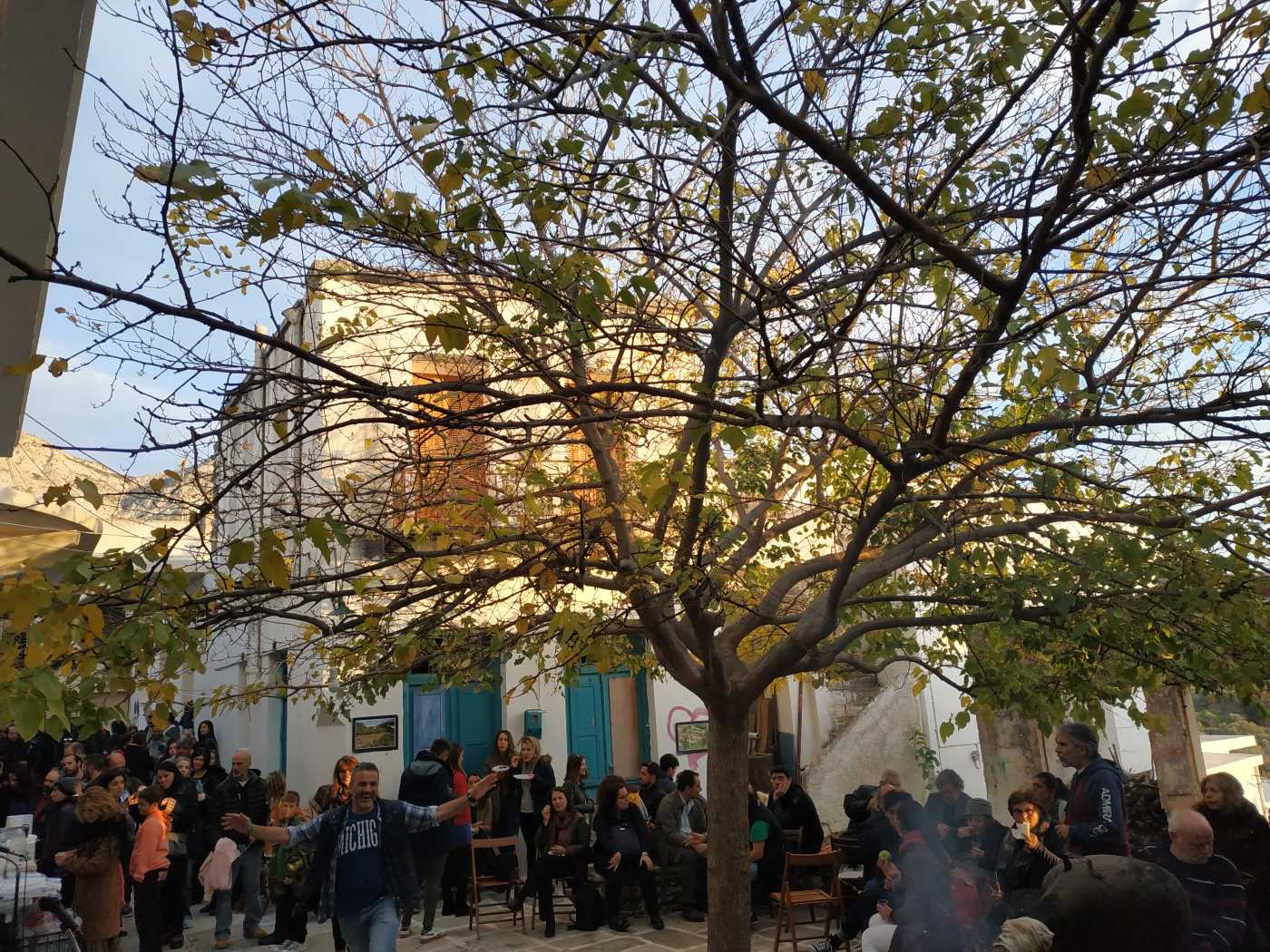
Its Fertile Region and Produce
The village is known for its sustainable agriculture practices, with its inhabitants using organic and traditional methods to grow their crops and raise their own livestock. The fertile land and abundant water supply of this region coming from the spring of mountain Fanari have helped create a verdant paradise, making it one of the most agriculturally productive areas not just on the island, but in Cyclades. The region is particularly famous for its fruitier trees, gardens with green vegetables, the most delicious tomatoes you can ever eat, water mellows, its vineyards, olive groves, citrus orchards and other crops that thrive in the sunny and temperate climate.
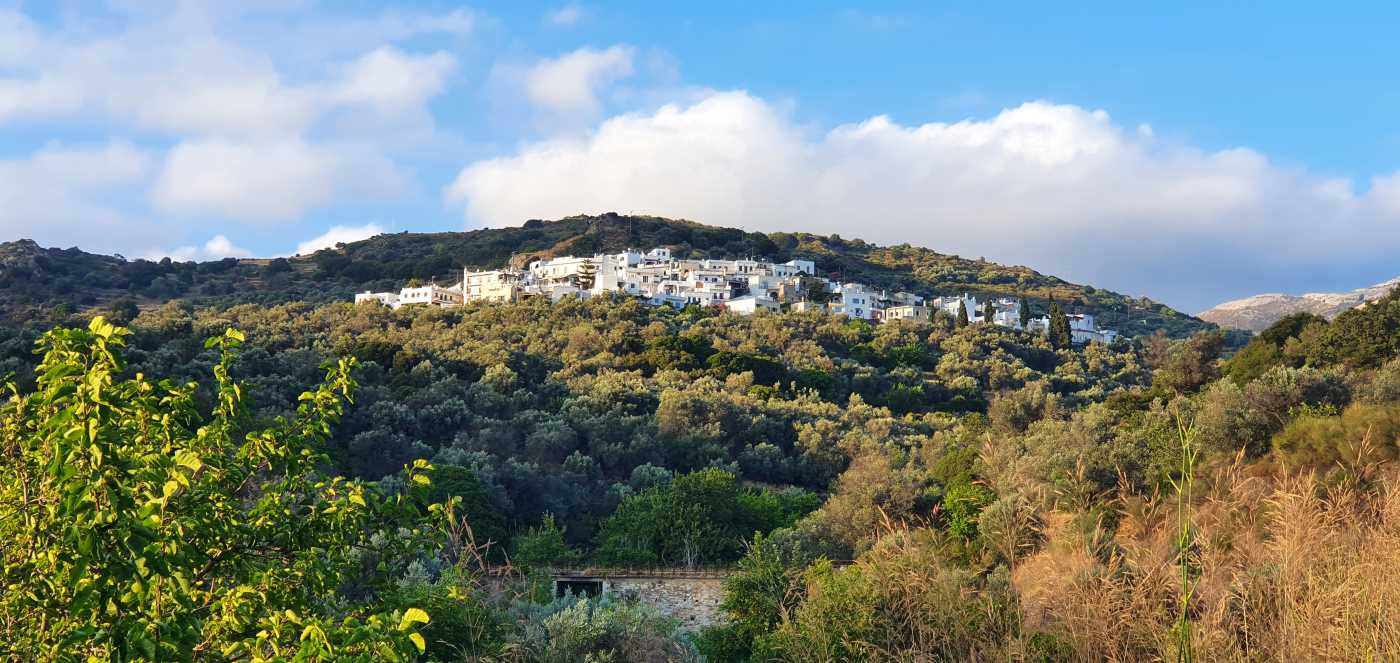
The villagers of Moni produce high-quality olive oil, the best organic wine on the island, and have lived in harmony with their land for generations, preserving the traditional ways of life that have been passed down from one generation to the next.
Two other important occupations of residents of Moni are cheese-making and vines. It deserves you to taste the pure flavor cheeses of pasturages, but also the wine that is produced by the households of the settlement, and not only the wine, but also the exceptional raki (arrack). You can find all these in the restaurants of the village and you can accompany with their “heady” sweet or peppery flavor, and the traditional mezes (titbit) that you will be served hospitably there.
Do not forget to also order homemade spoon sweets/liqueurs or to buy some. These sweets are usually served as a small treat with coffee or tea or as a dessert after a meal. They’re made using traditional recipes and locally sourced fruits and herbs, resulting in a delicious and authentic flavor. These liqueurs are a great way to experience the unique flavors of the mountainous Naxos and make for a perfect souvenir or gift.
The Oldest Byzantine Monument in Balkans – Panagia Drosiani

This place, Moni village, even if it is “burned” by the sun and by the full Greek sky, does never “burn” humans. Ethereal dew overflows from everywhere and caresses the gardens, sending a handful of golden but invisible rain above in the thirsty ground. Perhaps for this reason, precisely in this place, from ancient years, it was the natural place of the Goddess of wisdom, that was worshiped in Antiquity as “Athens Drosos” and that later, when Christianity prevailed, became “Virgin Mary Drosiani” or Panagia Drosiani. For this, however, remained the tradition that the icon of Virgin Mary of Drosiani (refresh = drosizo), because she diffused dew in the environment, but also she “sweat” moreover, each time that Moni and the residents were threatened by some danger, warning them thus, in time.
This icon is situated in a very ancient paleochristian chapel, in a small distance from the village. The church constitutes a very important monument with frescos even from the 6th century, concurrent or even more ancient from those at Ravenna. The older part of the chapel, with the primitive conical room and the three niches in the sides, is built with naked stonework and plates in the roof, while the place of manufacture leads as to the conclusion that there had been, probably, situated a mausoleum up to a moment in the past.
Housing, Architecture & Sustainability
Besides being a natural “battery” of energy, Moni is a village that deserves to be visited by all that come to Naxos, because it is a traditional village with old quaint homes, narrow streets, cobbled streets, and a strong commitment to sustainability by preserving its natural environment and cultural heritage.
One of the most significant sustainability efforts in Moni is the promotion of eco-tourism, which encourages visitors to experience the natural beauty of the village while minimizing their impact on the environment. The village has a strong tradition of using locally sourced materials, such as stone and olive wood, for construction and crafts, reducing the need for transportation and minimizing the carbon footprint.
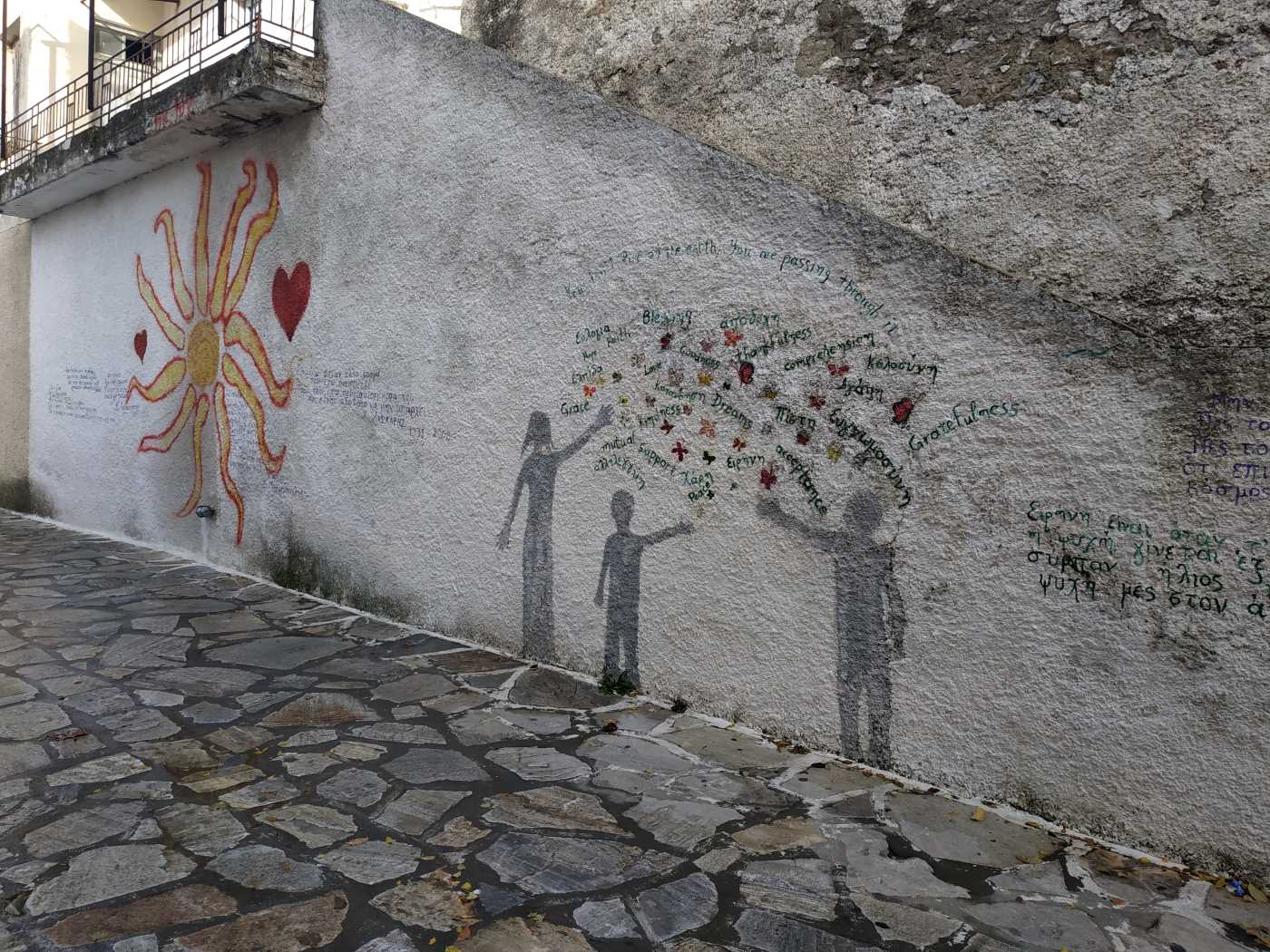
Stone dominates everywhere in the architecture, thus the craftsmen of the stone of Moni were always famous and manufactured a lot of work and other structures that blend seamlessly into the natural environment (bridges, booms, walls, etc.) all over the island. The houses are not only beautiful but also functional, with many of them having stood the test of time for hundreds of years. Visitors to the village can admire the skillful work of the stone craftsmen and appreciate the natural beauty of the stone buildings and walls that are an integral part of the landscape.
The renowned village of Apeiranthos was constructed by the talented craftsmen builders of Moni, who traversed the Fanari mountain on foot to reach their destination.
The area surrounding the village is rich in natural stone, providing an abundant and sustainable resource for the stone craftsmen. The craftsmen take great care in selecting the perfect stones for each project, ensuring that the colors and textures of the stones complement each other and create a harmonious overall effect.
Thus, after you reach the war memorial, in the beginning of the village, and after leaving your car, you can walk in the graphic alleys of the village and to see first of all the small “platza” (square) of the village. On your walk, you will see two old olive presses and a remnant of an old Venetian Tower in the Eastern part of the village and finally, the source of Moni and the well in the other end of the village.
Loom Weaving Textiles created only by the Women of Moni
But not only the men of Moni are famous as craftsmen of stone, famous, for other reasons, are also the women of the village. They are famous all over the world for their art in loom weaving, thus they traditionally practice textile art and they teach it with pious consequences to young girls. The weavers in Moni use a pedal loom to create their fabrics, which involves using foot pedals to raise and lower the warp threads while the weft threads are woven through.

The textiles they produce are often made with natural materials such as wool, 100% cotton, and silk, and feature intricate patterns and designs. Many of the designs are inspired by the natural environment and traditional motifs, such as geometric shapes and floral patterns.
The weaving process in Moni is still done by hand, using traditional techniques that have been passed down through generations. This means that each textile produced is unique and has its own character and history. The weavers take great pride in their craft and are committed to preserving this important part of their cultural heritage. Over 20 women nowadays continue this tradition in the village.
Wood Carving
Moreover, another very interesting art here is the wood carving, woodcut in olive.
Visitors can see artisans at work creating beautiful wood carvings from olive wood. There is a workshop located a little outside the village, on the way to Halki, adjacent to Kalliope’s House.
Olive wood is a popular material for carving in Greece due to its durability and unique grain patterns. The artisans at the workshop in Moni use traditional techniques to carve intricate designs and shapes into the wood, creating beautiful and functional objects such as bowls, utensils, and truly unique decorative items.
Visitors to the workshop can watch the artisans at work, learn about the history and techniques of olive wood carving, and even purchase some of the handmade items to take home as souvenirs. The wood carving workshop in Moni is a great way to experience the traditional arts and crafts of Naxos and Greece.
Local Taverns & Shops
There are three additional taverns that I cannot recommend specifically, as they are all owned by my relatives. However, I can give you a rundown of what each of them offers, and you can decide for yourself which one to try once you have a chance to visit them. Keep in mind that this is just an informal suggestion.
The Crazy Shrimp – A taverna that specializes in shrimp, crispy fried calamari, and pita souvlaki made with local meat, particularly during summer afternoons. Apart from that, they also have a daily menu board where they offer a variety of other dishes. Summer nights here are a feast. In the evenings, The Crazy Shrimp comes alive with a vibrant atmosphere of live music and locals flocking to be entertained.
*** The owner is my sister-in-law’s sister!
Taverna Panorama – The Panorama is the taverna in the middle that boasts a balcony with breathtaking views. Feast on mouthwatering traditional Greek dishes like moussaka, pastitsio, tzatziki, and a selection of other dishes that change daily, all made with the freshest ingredients produced by the owners. They also offer delectable local desserts. Their pita souvlaki made with succulent chopped meat is particularly delicious.
*** The owners are my sister’s in-laws!
The Paradisos – During the day, The Paradisos operates as a traditional café- kafeneio, but in the evenings, it transforms into a Café Bar Grill, offering delectable pita souvlaki made with locally-sourced meat, as well as Greek salad and other regional specialties. The restaurant also features a secluded balcony on the second floor, providing stunning views over the island.
*** The owner is my mother’s cousin!
*** Everyone is related. 🙂
Marble Exhibition
The local sculptors’ marble exhibition is an exquisite display of artistic mastery, showcasing the talent of skilled sculptors from Moni village. Each sculpture is crafted from the finest Naxos marble, renowned for its quality and unique veining patterns that lend each piece a distinctive character. As you wander through the exhibition, you’ll be struck by the sheer beauty and variety of the sculptures on display – from intricate, lifelike figures to abstract forms that challenge your perceptions of space and form. The exhibition is a celebration of the island’s rich artistic heritage and a testament to the skill and creativity of its local sculptors. Whether you’re an art enthusiast or simply appreciate the beauty of finely crafted objects, this exhibition is not to be missed.
Overall – Raw & Pure Life
In addition to agriculture, the local economy in Moni is supported during the summer by discerning travelers who are looking for unique experiences to forgotten spots on the map. The region’s scenic beauty, its rich history, and traditional way of life attracts visitors that are looking for that different vacation with true experiences, those who want to live the real authentic Greek way of living – raw as it is and pure!
Whether you’re exploring the local countryside, savoring the delicious local cuisine, you’re a nature lover, history buff, or simply soaking up the sun, and just looking for a relaxing escape, Moni village has it all. Don’t miss out on the opportunity to discover this gem of a village, trust me, it’ll be a trip to remember!
In essence, the beauty of an unadvertised village lies in its ability to transport you to a simpler, more peaceful way of life, away from the hustle and bustle of modern society. It offers a chance to connect with nature and with the locals, to experience their culture and traditions firsthand, and to leave feeling refreshed and rejuvenated.
So if you’re looking for a place where you can escape, slow down, and enjoy the simple pleasures of life, Moni is a rare destination. This is a village where time has indeed stood still….
ELaiolithos Luxury Retreat Hotel

Lastly, I would like to mention that Moni is also home to the ELaiolithos, located just outside the village, which is a stunning and eclectic accommodation hotel for those who wish to immerse themselves in the tranquility and natural beauty of the region.
On the premises, you’ll find a restaurant open to the public, that is a true culinary gem that serves up delectable healthy dishes made exclusively only from locally organic sourced ingredients. The menu is expertly crafted to showcase the unique flavors of the region, with a special focus on vegan and vegetarian options, as well as an explosion of flavors in each bite. You won’t want to miss out on the best crepe recipes you’ve ever tasted. The homemade jams are simply unbeatable. The restaurant also offers an impressive selection of craft cocktails, each one made with fresh herbs and homemade purees, adding a unique twist to your drink. With a commitment to quality and a focus on showcasing the best of the region, this restaurant is a must-visit for any foodie!
ELaiolithos is a fantastic destination to savor breathtaking scenery, indulge in mouth-watering regional dishes, relish in the pleasant atmosphere, experience sincere hospitality, connect with fellow human beings, and have fun!
We are waiting for you, and not only wish, but we are sure for your pleasant stay here, with the beautiful mountainous embrace, with the good company, but also the natural energy, the health, and the celestial dew!
Article written by Copyright © Helen Marakis. All rights reserved







